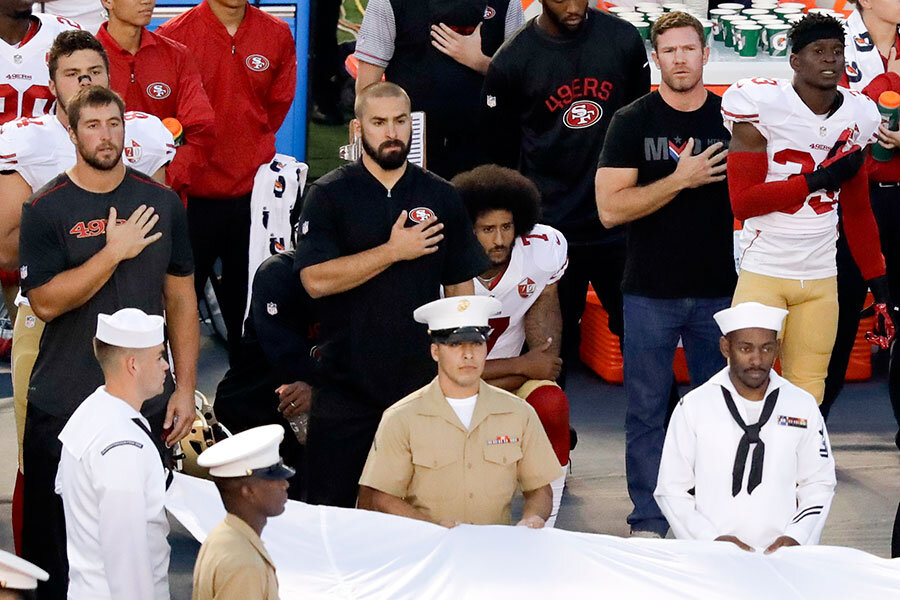For Colin Kaepernick protest, kneeling down means reaching out
Loading...
With a slight shift in body position, San Francisco 49ers quarterback Colin Kaepernick appears to have made a much larger shift mentally.
Make no mistake, Kaepernick is still protesting the police killings of black men. But by kneeling this past week instead of sitting down when the national anthem was played before a preseason game, he has signaled that he is open to listening to others.
Now he is winning varying degrees of support – from places expected and not-so-expected – marking a small pushback against the anger originally directed against him.
Megan Rapinoe, a midfielder for United States women’s soccer team, kneeled during the national anthem before a game with her pro club, Seattle Reign, in Chicago Sunday.
“I know what it means to look at the flag and not have it protect all of your liberties,” said Rapinoe, who is gay. “It was something small that I could do and something that I plan to keep doing in the future and hopefully spark some meaningful conversation around it.”
That same day, President Obama, speaking from the G20 summit in China, lauded Kaepernick’s “active citizenry,” though he did not condone Kaepernick’s protest.
“I’d rather have young people who are engaged in the argument than people who are just sitting on the sidelines and not paying attention at all,” he said.
The change in Kaepernick’s protest came before the 49ers final preseason game last Thursday night against the San Diego Chargers. When the anthem began, Kaepernick was kneeling, and he wasn’t alone.
The image of teammate Eric Reid kneeling at Kaepernick’s right and Nate Boyer, a former Green Beret and professional football player, standing to his left with his hand on his heart, illustrates how a little dialogue and compromise has begun to steer the debate away from the act of protest itself and toward the heart of the issue.
Kaepernick said he decided to kneel after a conversation with Boyer before the game. Boyer had published an open letter to Kaepernick in The Army Times the day before.
“Even though my initial reaction to your protest was one of anger,” he wrote. “I’m trying to listen to what you’re saying and why you’re doing it.”
It appears that Kaepernick listened to him as well. Boyer told the NFL Network that he encouraged the quarterback to kneel, rather than sit. He later tweeted a picture of the two:
Days of heated public debate followed Kaepernick’s initial sit-down protest earlier this preseason. Social media was ablaze with support and condemnation. While some Kaepernick jerseys were burned, overall Kaepernick jersey sales spiked, according to reports.
The day before the San Diego game, The Washington Post’s Mat Bonesteel lamented that the protest “could have sparked needed conversations on a number of subjects: on the treatment of black Americans … on patriotism’s place in society; on the importance of symbols. We seem to have skipped any and all of that.”
The prospect of athletes speaking up has always been fraught.
The response to Kaepernick’s protest echoed the public reaction in 1968 when African-American sprinters Tommie Smith and John Carlos made “Black Power” salutes on the podium at the 1968 Olympic Games, according to Kevin Blackistone, a visiting professor at the Philip Merrill College of Journalism at the University of Maryland and a sports columnist for The Washington Post.
“Just like in 1968, it wasn’t Kaepernick’s message that drew so much reaction; it was his method for dissemination,” wrote Professor Blackistone in a column last Sunday. “He dared to protest in the athletic arena, where we wrap sporting events in a prophylactic of patriotism used to demand political conformity and suppress discourse.”
In his letter, Boyer wrote of how he hoped to counter that by opening a dialogue. Indeed, some veterans have come out to support Kaepernick’s right to protest, with a #VeteransForKaepernick hashtag.
“There are already plenty of people fighting fire with fire, and it’s just not helping anyone or anything. So I’m just going to keep listening, with an open mind,” Boyer wrote.
“I look forward to the day you’re inspired to once again stand during our national anthem. I’ll be standing right there next to you.”








